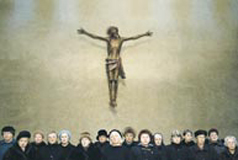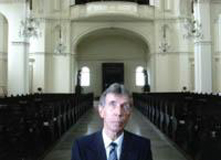|
Newest Reviews:
New Movies -
The Tunnel
V/H/S
The Tall Man
Mama Africa
Detention
Brake
Ted
Tomboy
Brownian Movement
Last Ride
[Rec]≥: Genesis
Hara-Kiri: Death of a Samurai
Indie Game: The Movie
Abraham Lincoln: Vampire Hunter
Old Movies -
Touki Bouki: The Journey of the Hyena
Drums Along the Mohawk
The Chase
The Heiress
Show
People
The Strange Affair of Uncle Harry
Pitfall
Driftwood
Miracle Mile
The Great Flamarion
Dark Habits
Archives -
Recap: 2000,
2001, 2002,
2003, 2004
, 2005, 2006,
2007 , 2008
, 2009 ,
2010 , 2011 ,
2012
All reviews alphabetically
All reviews by star rating
All reviews by release year
Masterpieces
Screening Log
Links
FAQ
E-mail me
HOME
| |
Jesus, You Know (Ulrich Seidl, 2003)
 Austrian filmmaker Ulrich Seidlís
documentary Jesus, You Know uses the filmed prayers of a half-dozen
churchgoers to present an unusual, yet insightful, look at the role that
religion plays in modern lives. Thanks to the approach used by Seidl in filming
his subjects, the mundane, or at least familiar, problems that these people
speak of become an informative, riveting and entertaining presentation of a
collective pathos. For a documentary, the film is unusually formally controlled.
As a result, one canít help but suspect that Seidl had his subjects stage
their actions so that the symmetry of his compositions was not upset. He
frequently photographs parishioners from head on, and when they pray, they speak
directly into the camera, addressing the audience as if they were the recipients
of the uttered prayers. The effect that this technique has is almost unsettling
at first, as if Seidl is not only exhibiting their religious being, but also
confronting us with it and forcing us to think of them primarily as spiritual
entities. When his subjects begin speaking, and weíre suddenly made privy to
their innermost passions and plights, this level of discomfort only rises
higher. Austrian filmmaker Ulrich Seidlís
documentary Jesus, You Know uses the filmed prayers of a half-dozen
churchgoers to present an unusual, yet insightful, look at the role that
religion plays in modern lives. Thanks to the approach used by Seidl in filming
his subjects, the mundane, or at least familiar, problems that these people
speak of become an informative, riveting and entertaining presentation of a
collective pathos. For a documentary, the film is unusually formally controlled.
As a result, one canít help but suspect that Seidl had his subjects stage
their actions so that the symmetry of his compositions was not upset. He
frequently photographs parishioners from head on, and when they pray, they speak
directly into the camera, addressing the audience as if they were the recipients
of the uttered prayers. The effect that this technique has is almost unsettling
at first, as if Seidl is not only exhibiting their religious being, but also
confronting us with it and forcing us to think of them primarily as spiritual
entities. When his subjects begin speaking, and weíre suddenly made privy to
their innermost passions and plights, this level of discomfort only rises
higher.
 A few times during he movie Seidl cuts
away from those praying, and shows the icon of Christ that the person is
directing their speech at. Alternatively, these representations seem stern,
compassionate and, in one case, almost mocking. It becomes apparent through
Seidlís editing that these icons are blank slates that allow the person in
prayer to project whatever meaning they need to onto them. Similarly, there
seems to be a consistent feeling that the problems of at least some of these
people are mostly self-inflicted. A troubled teenager complains that his family
harasses him for attending church services in lieu of more productive
activities. When he goes on to confess a compulsive tendency to turn television
and even Bible stories into erotic fantasies, it seems that his voluntary
involvement in the church is the sole reason for his guilt. Though we donít
ever see his family, itís not very likely that they are the source of the
pressures that he feels. Similarly, the other people we hear speaking seem to
have their lifeís problems exacerbated by their involvement in the church.
Even though each of them obviously draws strength from their prayers, their
involvement in the church doesnít come without its own costs. When the actual
content of his subjectsí prayers forms not only semi-melodramatic
mini-narratives, but also a thematically consistent vibe of romantic
frustration, it grows even more difficult not to question the veracity of the
entire enterprise. Ultimately, though, it doesnít much matter if the people we
see are expressing their own sentiments or scripted ones. Seidlís attitudes
toward these people are whatís important here, and they are obvious. A few times during he movie Seidl cuts
away from those praying, and shows the icon of Christ that the person is
directing their speech at. Alternatively, these representations seem stern,
compassionate and, in one case, almost mocking. It becomes apparent through
Seidlís editing that these icons are blank slates that allow the person in
prayer to project whatever meaning they need to onto them. Similarly, there
seems to be a consistent feeling that the problems of at least some of these
people are mostly self-inflicted. A troubled teenager complains that his family
harasses him for attending church services in lieu of more productive
activities. When he goes on to confess a compulsive tendency to turn television
and even Bible stories into erotic fantasies, it seems that his voluntary
involvement in the church is the sole reason for his guilt. Though we donít
ever see his family, itís not very likely that they are the source of the
pressures that he feels. Similarly, the other people we hear speaking seem to
have their lifeís problems exacerbated by their involvement in the church.
Even though each of them obviously draws strength from their prayers, their
involvement in the church doesnít come without its own costs. When the actual
content of his subjectsí prayers forms not only semi-melodramatic
mini-narratives, but also a thematically consistent vibe of romantic
frustration, it grows even more difficult not to question the veracity of the
entire enterprise. Ultimately, though, it doesnít much matter if the people we
see are expressing their own sentiments or scripted ones. Seidlís attitudes
toward these people are whatís important here, and they are obvious.
52
12-13-03
Jeremy Heilman
|